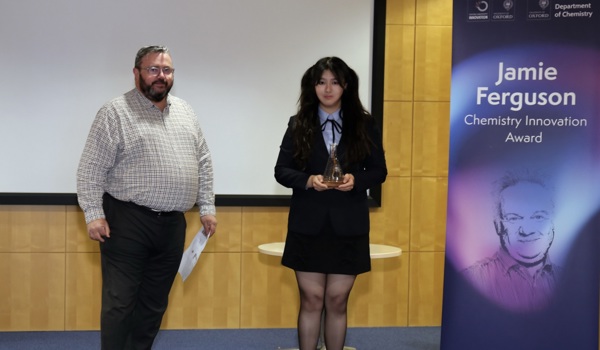Biography
Vicente Grau is a Professor of Biomedical Image Analysis at the Institute of Biomedical Engineering (IBME) and a Professorial Fellow in Engineering at Mansfield College.
Vicente holds a PhD in medical image analysis from Universidad Politecnica de Valencia, in Spain. After spending two years at Brigham and Women’s Hospital, Harvard University and the ONH Biomechanics Lab at LSU Health Sciences Center, he joined the University of Oxford in 2004. He was awarded the title of Professor in 2015.
Teaching
- Lecturer in the MEng in Engineering Science, University of Oxford
- Associate Director, Systems Approaches to Biomedical Sciences Centre for Doctoral Training (SABS CDT)
- Professorial Fellow at Mansfield College
Most Recent Publications
Delineating Mpl-dependent and -independent phenotypes of Jak2 V617F- positive MPNs in vivo
Delineating Mpl-dependent and -independent phenotypes of Jak2 V617F- positive MPNs in vivo
Synergies Among Clinicians, Academia, and Industry in the Age of Artificial Intelligence.
Synergies Among Clinicians, Academia, and Industry in the Age of Artificial Intelligence.
MSP-tracker: A versatile vesicle tracking software tool used to reveal the spatial control of polarized secretion in Drosophila epithelial cells
MSP-tracker: A versatile vesicle tracking software tool used to reveal the spatial control of polarized secretion in Drosophila epithelial cells
Editorial for Special Issue on Foundation Models for Medical Image Analysis.
Editorial for Special Issue on Foundation Models for Medical Image Analysis.
Reticulin-Free Quantitation of Bone Marrow Fibrosis in MPNs: Utility and Applications.
Reticulin-Free Quantitation of Bone Marrow Fibrosis in MPNs: Utility and Applications.
Research Interests
Vicente’s research focuses on the development of artificial intelligence (AI)-enabled methods to improve the understanding of human anatomy and physiology, and provide solutions for healthcare. He is particularly interested in the combination of medical images with other information sources to build multimodal algorithms, and in leveraging the power of large databases for population-level studies. His research ranges across multiple clinical applications, with a special interest in cardiovascular medicine.
Current Projects
Reconstruction and Analysis of Cardiac Shape from Medical Images
Cardiac shape can change in the presence of multiple diseases, both directly as a result of the pathology or in adaptation to changed electromechanical conditions. We are developing and validating AI methods to automatically reconstruct the shape of individual hearts from clinical images, using an efficient point-cloud structure, and have applied these to the analysis of thousands of scans within the UK Biobank. Our results show that shape can be used to predict the risk of different cardiovascular diseases, with higher accuracy than currently existing methods.
Cardiac Anatomy and Function
Anatomy and function are closely interlinked. We are exploring the links between cardiovascular anatomy and electromechanical using AI-enabled models, generated either directly from clinical data or from physically-realistic computer simulations. Results show the ability of our models to solve inverse problems in computer simulations, and to link anatomical characteristics to electrophysiological patterns found in electrocardiograms.
Digital Contrast in Computed Tomography scans
CT scans are often performed after the injection of a contrast agent. This increases cost, acquisition time and risk to the patient, and produces a significant amount of clinical waste. We are developing and validated machine learning methods that produce “digital contrast” images, simulating the appearance of real contrast agents using AI algorithms. This research is aligned with the Net Zero agenda in Healthcare and has been funded by the European Union as part of the NetZero AICT consortium.
Analysis of Interventional Cardiac Angiography (ICA) Scans
ICA scans are the main interventional imaging modality in cardiovascular disease. It consists in a number of X-ray projections, acquired while injecting contrast through a catheter to highlight coronary vessels. While three-dimensional structure of these vessels is fundamental, it can only be partially inferred from these two-dimensional projections. This is made more complicated by the presence of breathing and cardiac motion. We are developing methods for the automated analysis of ICA scans, including the segmentation of blood vessels, and the reconstruction of their three-dimensional structure, with the help of modern AI methods.
Multimodal Medical Data Integration with Application to Risk Assessment
Data in medical applications can come from many sources (modalities), including demographic or lifestyle information, results of clinical multiple clinical tests, images and signals. AI methods are a powerful tool for combining the information of these multiple modalities in a synergistic form to improve clinical assessment and treatment planning.
Most Recent Publications
Delineating Mpl-dependent and -independent phenotypes of Jak2 V617F- positive MPNs in vivo
Delineating Mpl-dependent and -independent phenotypes of Jak2 V617F- positive MPNs in vivo
Synergies Among Clinicians, Academia, and Industry in the Age of Artificial Intelligence.
Synergies Among Clinicians, Academia, and Industry in the Age of Artificial Intelligence.
MSP-tracker: A versatile vesicle tracking software tool used to reveal the spatial control of polarized secretion in Drosophila epithelial cells
MSP-tracker: A versatile vesicle tracking software tool used to reveal the spatial control of polarized secretion in Drosophila epithelial cells
Editorial for Special Issue on Foundation Models for Medical Image Analysis.
Editorial for Special Issue on Foundation Models for Medical Image Analysis.
Reticulin-Free Quantitation of Bone Marrow Fibrosis in MPNs: Utility and Applications.
Reticulin-Free Quantitation of Bone Marrow Fibrosis in MPNs: Utility and Applications.





